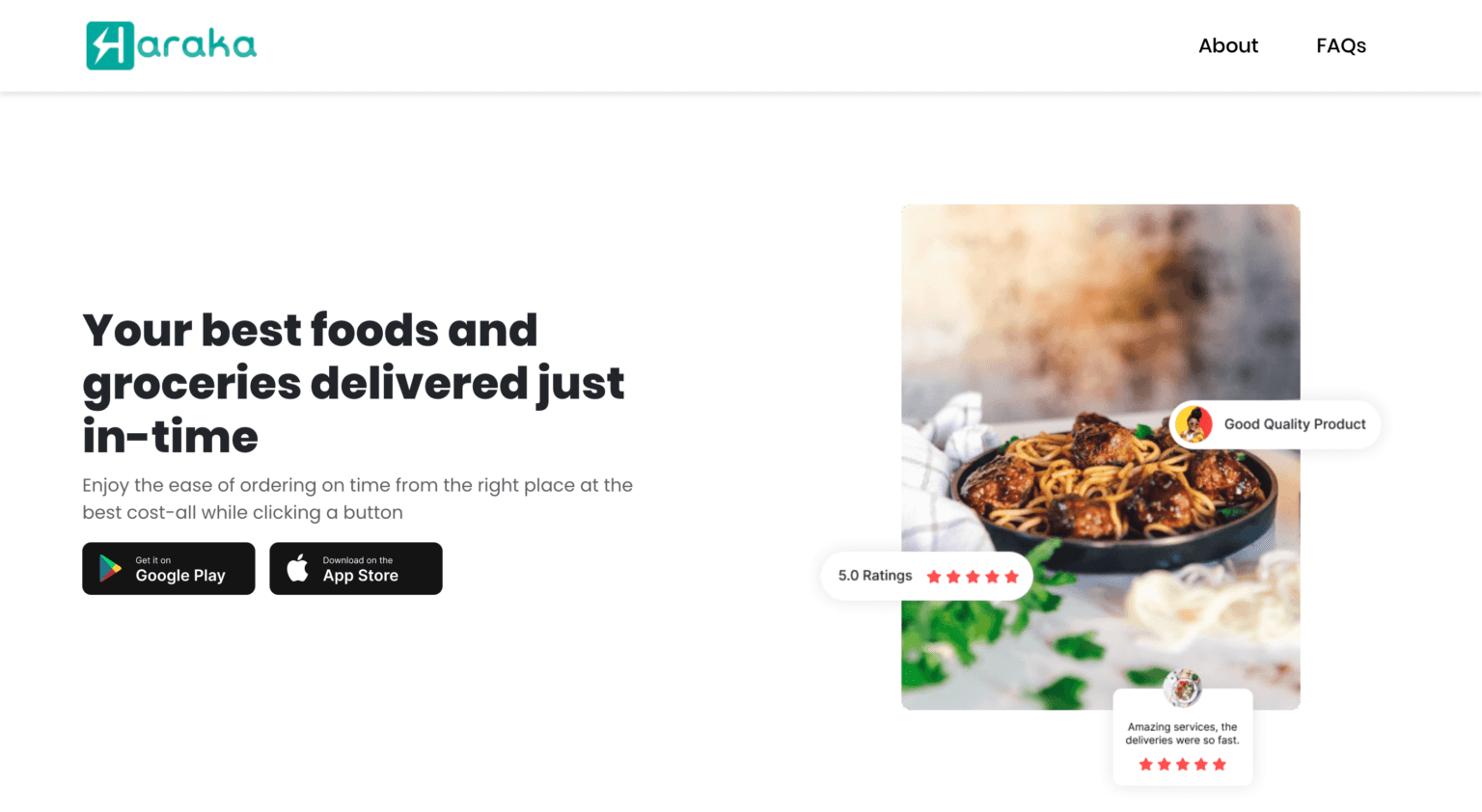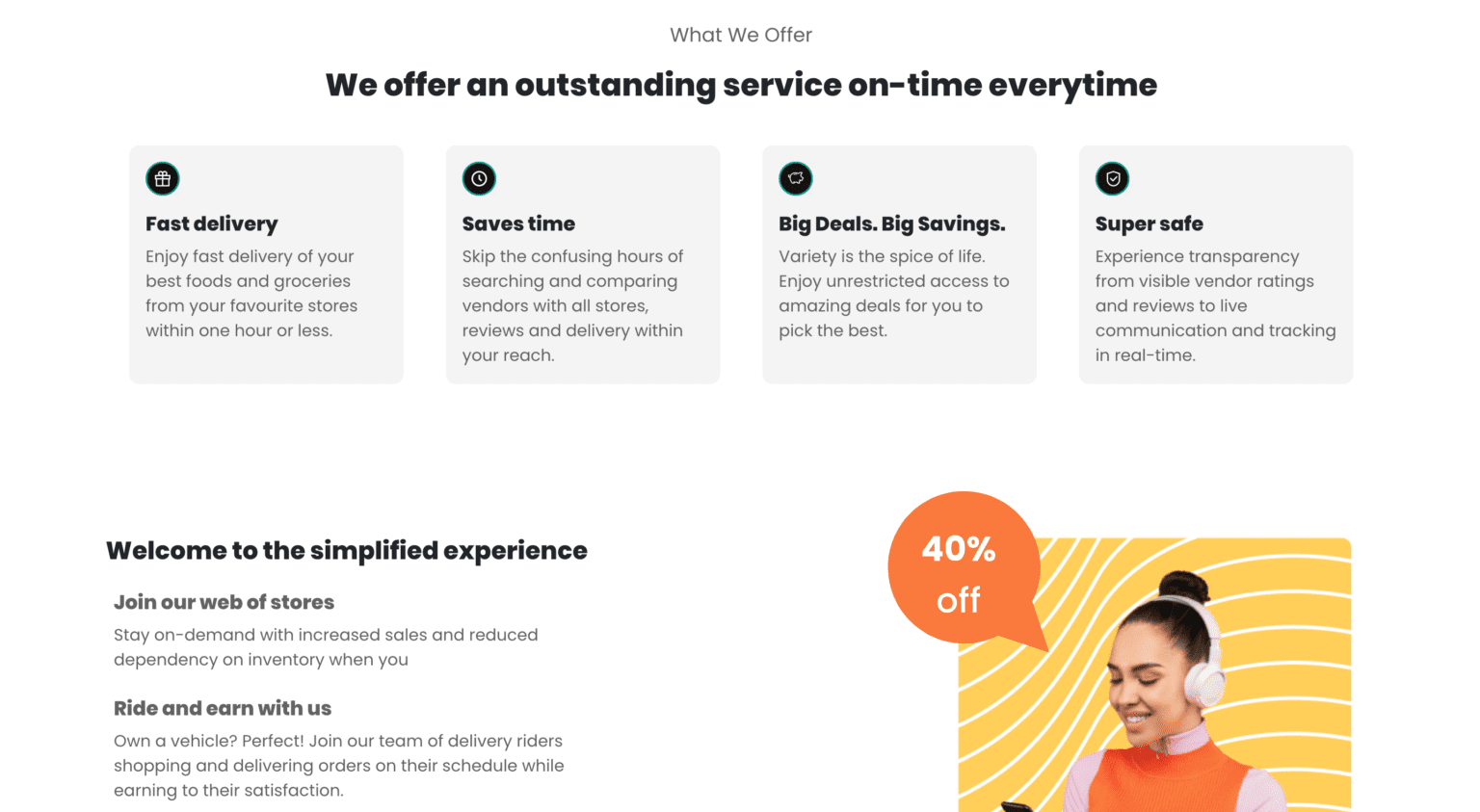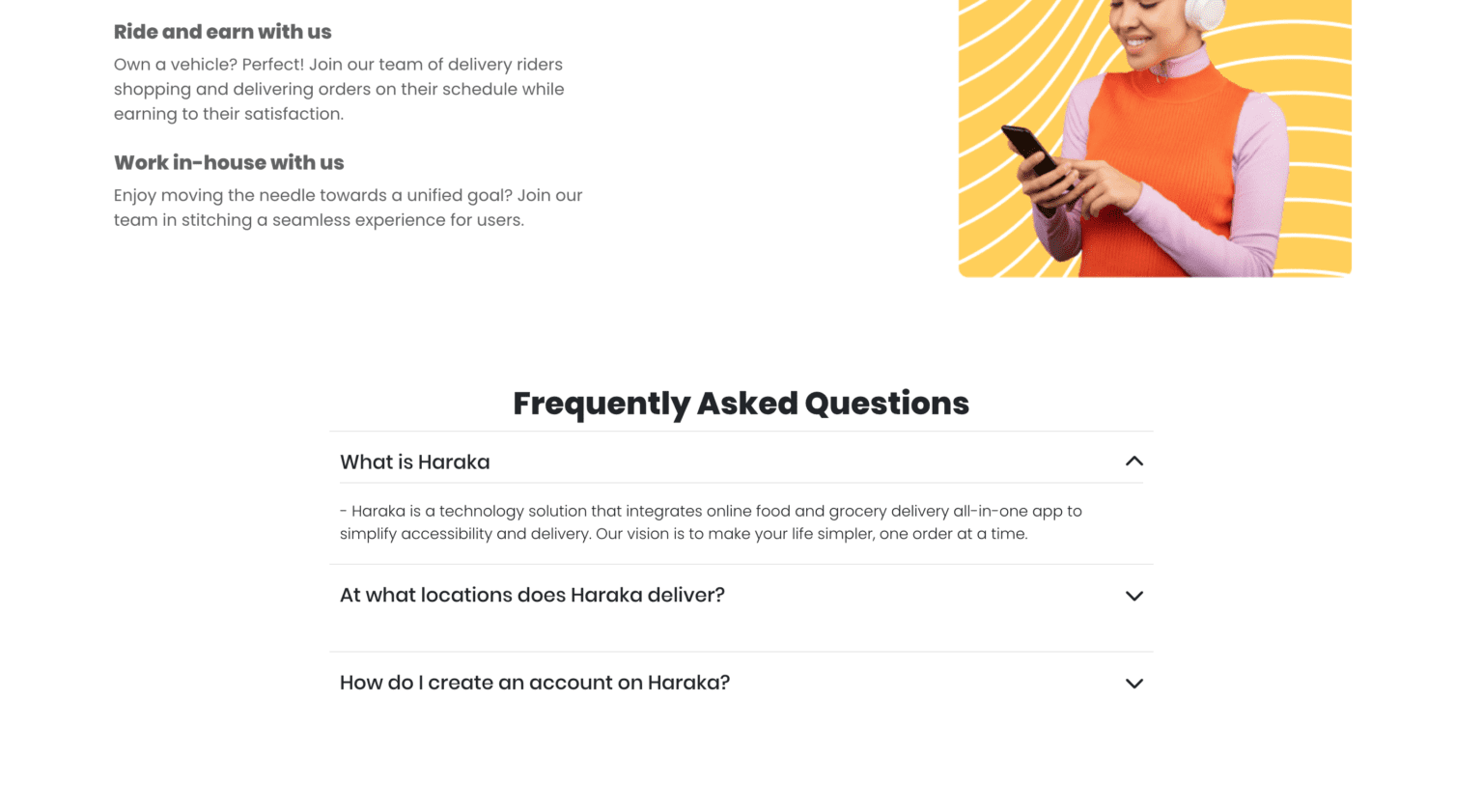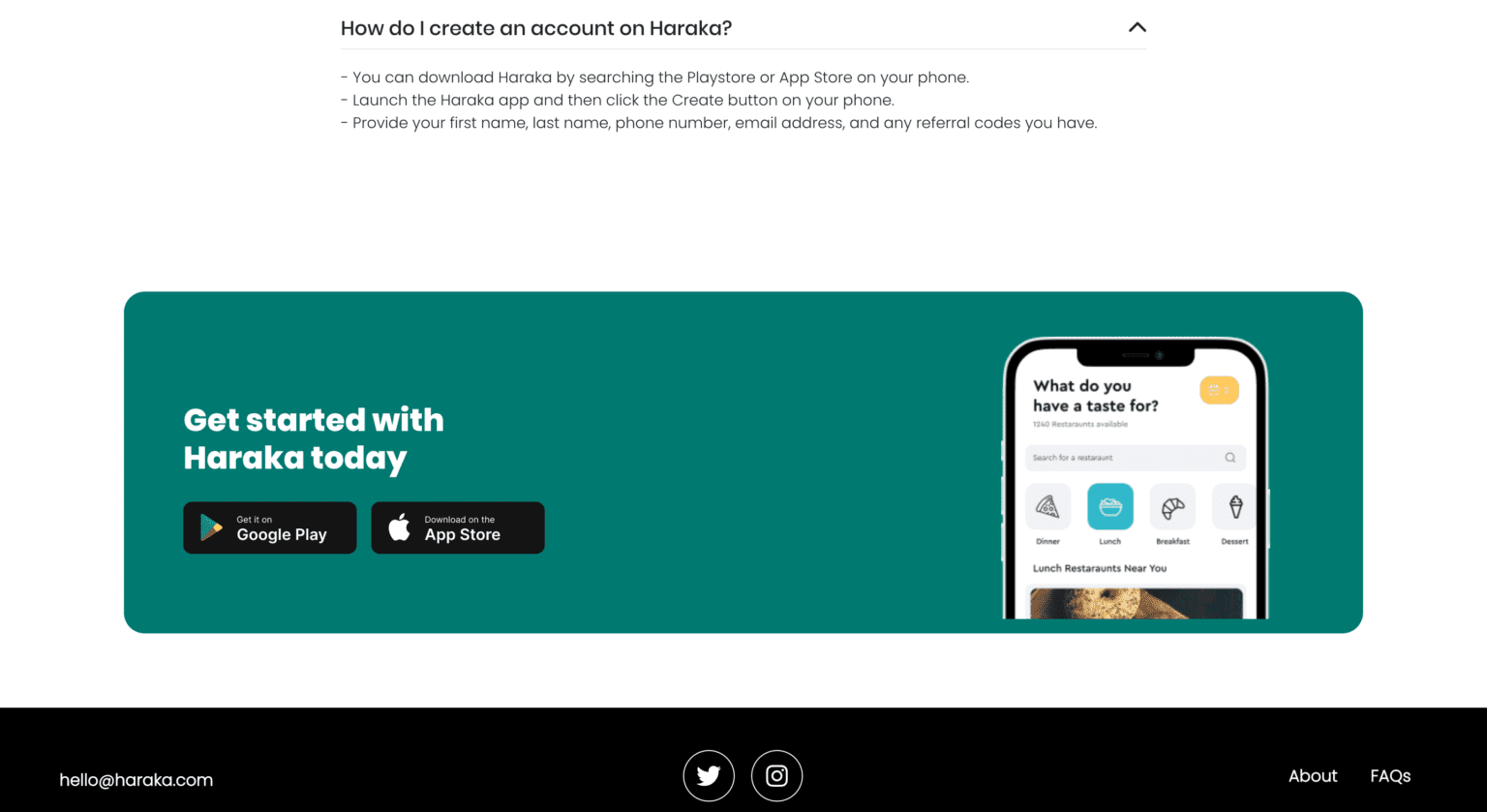Landing page UX copywriting
Landing page UX copywriting
Overview:
Haraka is an Uber-style application that aims to make life easier through same-day food and grocery delivery services.
One of Haraka’s Value Propositions is its use of the aggregator business model to reduce vendors’ dependency on inventory management through a direct partnership with a focus on providing exceptional on-time delivery service to end-users.
Goal
To clarify Haraka’s messaging and increase user downloads.
- My role: UX copywriter
- Stakeholders: Lead designer, product owner
- Timeline: 3 days
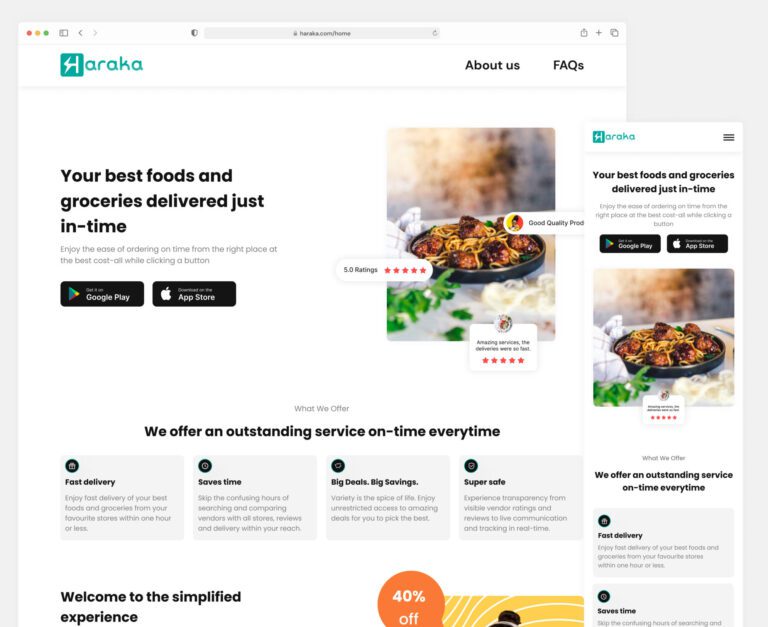


Challenges:
How can we get more users to sign up for our product?
Hypothesis
For this project, I had three users in mind; the vendors, the end-users, and the client.
During my research and audit of competitor websites like uber eats, chowdeck.com, and piki.co.tz I found their primary messaging wasn’t very inclusive of all users. They only targeted the end customers.
As an advocate for inclusive UX writing ( the process of writing to intentionally include and create welcoming experiences for all users/readers), I picked up the challenge of tailoring Haraka’s messaging to overlap the goals of all users.
To do this efficiently, I realized that if I addressed each user’s need individually than as a whole, our messaging would resonate more with them. Here, the paradox of specificity will come to play during my research.
I believe this will distinguish Haraka from other competitors in the food tech space.
Approach:
As I set out to overcome this challenge, I had to map out a strategy.
Some of the questions I asked myself were:
- Who are the users?
- What will the user come to this site or use the product for?
- What value does the user seek?
- Why does this value matter?
- What goals do the users have?
- How can the user achieve their goals using this site?
- Which words will convey this value to both target audiences?
This brainstorming session would serve as a basis for my next step.
Audience Research
I proceeded to get to know my target users better, to ground myself better in their goals, fears, and motivations.
I had my lightbulb moment during the conversation mining process when I noticed “time” as a consistent repetition for both audiences.
Why time?
To have a clear vision of why time was of great importance, I proceeded to build user stories and acceptance criteria.
End - users
The experience end customers expect from an online ordering and delivery service is centered around time and convenience.
Scenario: From their ability to quickly explore a range of options to making payment and their orders delivered just in time for lunch, picnic, or whatever that means for them.
Vendors
The cost of inventory remains a big concern for vendors. They just want to have enough products to absorb maximum market demand without waste to reduce their dependency on inventor management.
User story: As a Vendor, I just want to move from stocking goods in a Just-in-case manner to Just-in-time on an as-needed basis.
Compare and Contrast
After understanding both users’ pain points and motivations, I returned to my drawing board to cross-examine the USP and benefits Haraka had that met these criteria.
USPS
- The same-day delivery promise could be translated as time-saving.
- The aggregator business model in direct partnership with brick-and-mortar vendors could be translated as saving costs.
Solution
After brainstorming, gathering insights, and building use cases, I focused on a benefit-driven messaging.
I leveraged Haraka’s primary value proposition; to remove the dependence on inventory management by delivering goods and services to end-users on an “as they need basis.”
With further research, I figured this method is also known as the ‘JUST IN TIME’ inventory model; in fact, JUST-IN-CASE is also an actual inventory model.
” The just-in-time (JIT) inventory system is a management strategy that minimizes inventory and increases efficiency.” – Investopedia
Viola! I figured the golden thread.
It is far more convenient for users to visit one app, compare pricing and ratings, and place orders. And the vendors also do not have to spend so much on inventory or marketing. A win for everyone!
Landing page UX copy
Content Testing
Due to time constraints, I used the quick guerrilla testing method to check if users resonated with the landing page copy.
My goal was to check if the copy provided enough context about the product and its uses.
For my participants: I relied on the statistics I gained during my audience research. Statista states that 28.4% of people who order food online regularly fall into the 25–34 age group. So I ensured the test participants fell within this age bracket.
Outcome
I was pleased with where we landed on this landing page, especially providing the right words with beneficial meanings to users.
Creating a messaging that was inclusive of both target users was fulfilling because other competitors’ messaging spoke to one side of the audience.
On the other hand, the client was pleased. In his words, “Nice work Kat. Really nice copy you’ve made. And when he sent me the final design, he said, “Here’s the landing page, simple and concise with a fitting copy.
MY INPUT
Results
The landing page is live! Do check it out. If given the go ahead, I plan to measure performance through the following metrics:
- Number of signups
- Traffic & repeat traffic
- Engagement – shares, reviews, etc
- Call to action – Inquiries, conversions, etc.
What did I learn?
Challenge yourself constantly or the brief as Putu M. Wijaya – Product Writer Lead at tiket.com, wrote in his article “5 Things Great UX Writers Do, But The Good Ones Don’t” – Good writers understand the brief; great writers challenge it.
Ideation and brainstorming, like in design thinking, help you solve problems and create solutions from a unique angle. Like how I came up with the words “Just in case” and “Just in time” without knowing those were actual inventory models all connected to my goal.
I guess we never know until we challenge ourselves.


